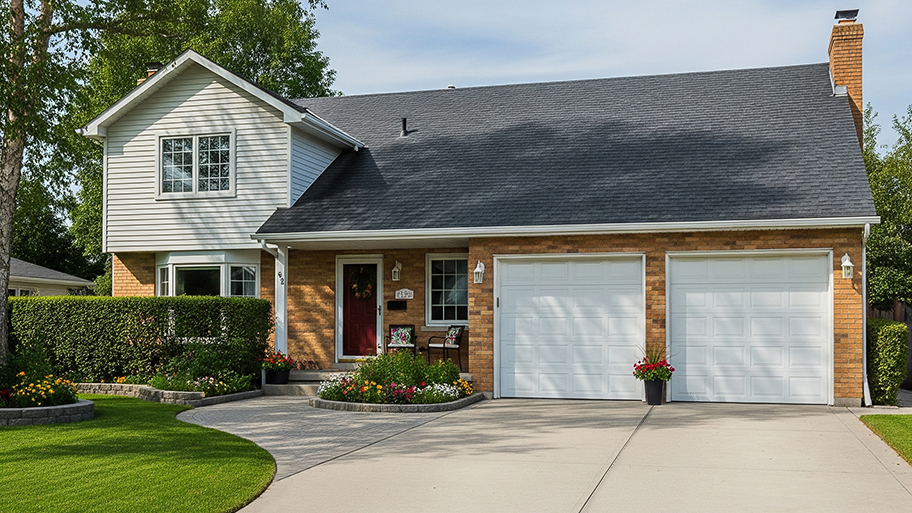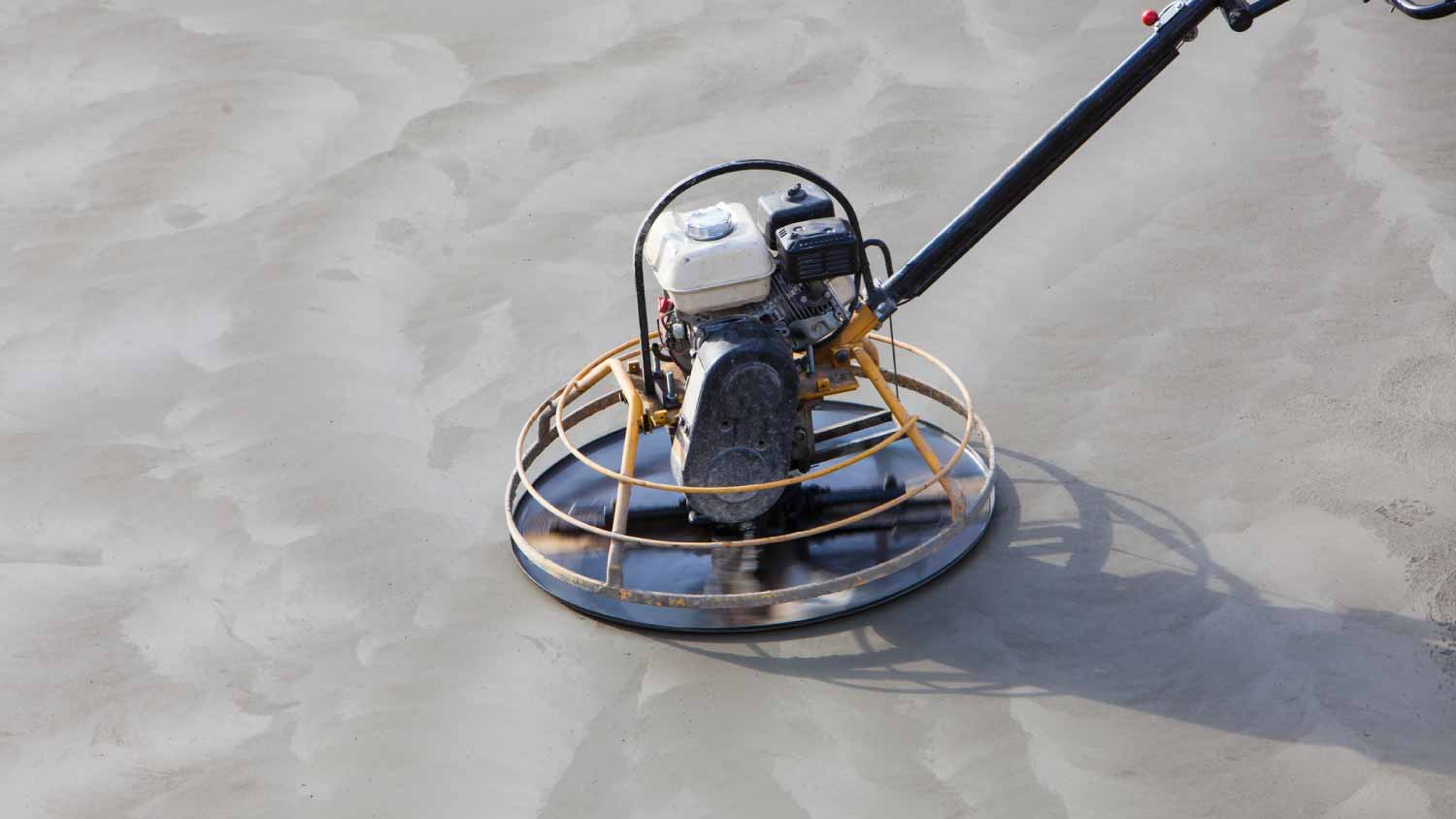
Concrete driveways stand up to a lot of pressure over the years. How much do concrete driveway repairs cost when it's time to give it a little TLC?
Grinding concrete spiffs the old and refines the new to create long-term strength


Pros charge anywhere from $3 to $6 per square foot to grind or resurface concrete, but it’s money well spent for a smooth, durable result.
Concrete grinding is labor-intensive, messy, and tough for DIYers—especially for larger slabs or uneven surfaces.
Renting a concrete grinder costs $45 to $500 per day, and improper use can damage your slab or the tool.
Concrete resurfacers will also handle affiliated jobs, like prepping the slabs and cutting the edges.
A pro will handle prep, edge cutting, and post-grind sealing—key steps for a polished, long-lasting finish.
New concrete pours need refinement, and old concrete often needs a face-lift from weather or root damage—both can get it from grinding concrete. A look at how to grind concrete will give you a better idea of whether the concrete project you have in mind is doable at your DIY skill level. Grinding concrete isn’t easy, but depending on your experience, you could potentially do it yourself.

There are a few reasons to use a grinder when working with concrete. With a new pour, grinding evens out the surface of the concrete slab, removing raised areas that could cause trips, falls, or pooling. A more extensive grinding process may also be the first step in creating the glossy finish of polished concrete floors.
Damage can also be a reason to grind concrete. Over time, cracks and holes can appear due to expansion and contraction or root damage, which can weaken the concrete’s structure. Grinding gives you access to deeper layers where the concrete isn’t damaged, so you can pour another layer over the top or refinish the surface if the slab is deep enough.
Before you flip the switch on a concrete grinder, you need to do some groundwork. First, test the concrete’s hardness using a Mohs stick and a scratch test kit. The hardness determines the different grits of the diamond grinding pads you’ll need. Most projects require various grits to get the desired results.
Second, clean the concrete, removing dust, debris, finishes, or adhesives that could get caught in the grinder or gum up the grinding pads and affect the final finish.
Third, fill in any cracks or holes with epoxy or another semi-solid filler. Make sure you have the following tools handy:
Trowel
Sponges
Float paddle
If you have any concrete edges that need cutting, this would also be the step where you take care of that.
Fourth, concrete grinding creates a lot of dust. Most rented concrete grinders come with a skirt and vacuum to collect dust. If you happen to rent a grinder that doesn’t have a skirt and vacuum, you’ll need to use a vacuum or wet or dry vacuum to keep your space clean and help prevent you from breathing in dust.
Finally, make sure to use the following protective gear:
Safety glasses or goggles
Ear protection
Dust mask
Gloves

You’ll need to rent a concrete grinder unless you know someone in the concrete business who’ll let you borrow one, which can save money on concrete removal costs.
Concrete grinding takes some practice to get it right. The steps below cover the process, though pros may add a few more steps based on the desired result.
Put the coarsest grit grinding pad you have on the concrete grinder head(s). You want to start with coarse and work your way to a finer grit.
Adjust the grinder’s rotation speed, which you’ll need to do depending on the grinder design, pad grit, and the hardness of the concrete. Run coarse grit pads at lower speeds to prevent the teeth from skipping over the concrete’s surface.
Move over the concrete methodically so you don’t miss spots or spend too much time in one area. The speed at which you move across the floor may take some practice. Go too slow, and you can cut too deeply into the concrete. However, go too fast, and you might not cut deep enough.
Depending on your final goal for the concrete, you may need to change out the diamond grinding pads for those with a finer grit. Once you’ve put on the new pads, grind the entire area again.
If you’re repairing the concrete, you may only need a couple of passes over the entire surface. On the other hand, polished concrete requires several grinding passes, applying a densifier, grinding and polishing, and a final application of a concrete sealer.
Certain concrete shapes may require an edge grinder, such as when grinding concrete that’s flush with a wall or in tight corners or curves. The steps for using the edge grinder are the same as for a standard concrete grinder:
Put a coarse-grit diamond grinding pad on the grinder
Adjust the rotation speed
Decide on a path and methodically move over the concrete’s surface
Put on a pad with a finer grit
Completely grind the floor again
Continue to change to finer grit pads and grind the entire floor until you get the desired finish
If you’re working with a small space, tight corners, or a concrete countertop, you may not need a large concrete grinder or edge grinder. Instead, you can use a hand grinder, like an orbital sander or belt sander. For very small projects, you can even use sandpaper or a sandpaper block. If you know or are willing to learn how to sand concrete you can save money, though you’ll use more muscle power.
The steps for using a hand grinder are the same as those for using a standard concrete grinder and edge grinder:
Start with a coarse-grit diamond grinding pad
Using the right grinder rotation speed
Planning the grinding path
Gradually using grinding pads with finer and finer grit

One of concrete’s many benefits is that it’s incredibly low maintenance. However, low maintenance does not mean no maintenance. Here’s how to keep your concrete in tip-top shape:
Dirt and general debris aren’t usually a problem. However, oil and chemicals can absorb into concrete’s porous surface and eventually damage the structural integrity. Clean up spills in a timely manner to prevent stains and damage.
In colder climates, you might not be able to avoid chemical deicers. However, avoid them if you can because they can break down the concrete over time.
You don’t have to apply a concrete sealer, but a sealer can reduce the amount of moisture the concrete absorbs and prevent stains. For newly poured concrete, you should wait 28 days before applying the sealer so it can fully harden.
Reseal your concrete every few years. Some concrete may need resealing as often as every two years, while others may only require resealing every five to 10 years, depending on the strength of the concrete, climate, weather, and maintenance.
Using a concrete grinder requires some technique and practice. An experienced DIYer can probably pull off a small project, like a countertop or smoothing corners. However, for most projects, a concrete resurfacing pro near you will know the right diamond grinding pad grits to use based on the concrete’s hardness and the many other factors that affect the final look of the concrete. They’ll also have access to the equipment, which can be expensive to rent, and they have the experience to use it.
From average costs to expert advice, get all the answers you need to get your job done.

Concrete driveways stand up to a lot of pressure over the years. How much do concrete driveway repairs cost when it's time to give it a little TLC?

Between the endless customizations and decades of strength, the cost of a concrete driveway may be worth the investment. Let's break down your bottom line.
Need to breathe new life into your exterior stoop? Use this guide on concrete step repair cost to see the price of a professional repair.

Sinking concrete can lead to major property damage if you don’t solve the underlying issue. Learn what causes concrete to sink and how to fix the problem.

A concrete driveway can add value to your home. Learn what factors influence your return on investment (ROI) for a new concrete driveway

Learn about how thick a concrete driveway should be and what factors affect the thickness before pouring concrete to ensure safety and durability.